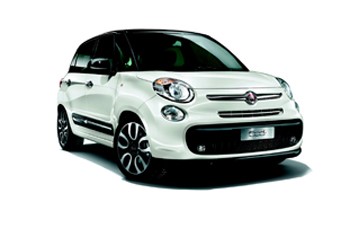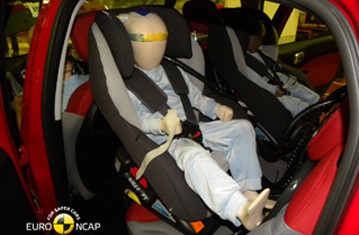Find more information in the General Comments section of the assessment
Find more information in the Rating Validity tab of the assessment
- See More
- See More
- See More
- See More
- Good
- Adequate
- Marginal
- Weak
- Poor
 Passenger
Passenger
 Driver
Driver
 Front Seat
Front Seat
 Car
Car
 Pole
Pole
- Good
- Adequate
- Marginal
- Weak
- Poor


Passenger
outboard
center
Fitted to the vehicle as standard
Not fitted to the test vehicle but available as option
Not Available
Both the 3 year and 1½ year dummies were sat in rearward-facing restraints and, in the frontal impact, the heads of both dummies were well contained by the protective shells. The rearward-facing restraint of the 1½ year infant moved forward and damaged the seat back of the front passenger seat. However, this had no influence on dummy results and was not penalised. In the side impact, both dummies were properly contained within the protective shells of their restraints, minimising the likelihood of dangerous head contact with parts of the car interior. The passenger airbag can be disabled to allow a rearward-facing child restraint to be used in that seating position. However, information provided to the driver regarding the status of the airbag is not sufficiently clear. The dangers of using a rearward-facing restraint without disabling the airbag were clearly explained on labels in the car.
- Good
- Adequate
- Marginal
- Weak
- Poor

Head Impact 15.0 Pts
Pelvis Impact 2.5 Pts
Leg Impact 6.0 Pts
The bumper scored maximum points in Euro NCAP's tests, providing good protection to pedestrians' legs in all areas. In most areas likely to be struck by the head of a child, the bonnet provided good protection but provided predominantly poor protection in those areas likely to be struck by the head of an adult.
- Good
- Adequate
- Marginal
- Weak
- Poor
| System Name | ESC | |
| Performance | ||
| Vehicle Yaw Rate @ COS + 1.00 s | 2.68% | meets ECE requirements |
| Vehicle Yaw Rate @ COS + 1.75 s | 1.97% | meets ECE requirements |
| Lateral Displacement @ BOS + 1.07 s | 2.97 m | meets ECE requirements |
| Applies To | Front seats | ||
| Warning | Driver Seat | Front Passenger(s) | Rear Passenger(s) |
| Visual | |||
| Audible | |||
|
|||
The 500L has electronic stability control as standard equipment and passed Euro NCAP's test requirements. A driver-set speed limitation device is standard equipment on some variants but not all, and the system was not assessed. Seatbelt reminders for the two front seats are fitted to all variants.
- Specifications
- Safety Equipment
- Videos
- Advanced Rewards
- Rating Validity
Specifications
Tested Model Fiat 500L 1.4 petrol 'Easy' 4×2, LHD
Body Type - 5 door hatchback
Year Of Publication 2012
Kerb Weight 1245kg
VIN From Which Rating Applies - applies to all 500L's of the specification tested
Class Small MPV
Safety Equipment
Note: Other equipment may be available on the vehicle but was not considered in the test year.
Fitted to the vehicle as standard
Fitted to the vehicle as option
Not fitted to the test vehicle but available as option
Not Available
Not Applicable
Videos
Advanced Rewards
Rating Validity





Find more information in the General Comments section of the assessment
 Share
Share









The passenger compartment remained stable in the frontal impact. Protection of the passenger dummy was good for all body regions. Dummy readings indicated good protection of the knees and femurs of both the driver and passenger. FIAT showed that a similar level of protection would be provided to occupants of different sizes and to those sat in different positions. In the side barrier test, the 500L scored maximum points, with good protection of all body areas. Even in the more severe side pole test, protection of the chest was adequate while that of other body regions was good. The seat and head restraint provided marginal protection against whiplash injuries in the event of a rear-end impact.